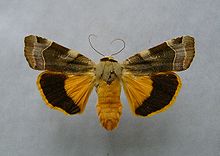Noctua fimbriata
| Broad-bordered yellow underwing | |
|---|---|

| |

| |
| Scientific classification | |
| Domain: | Eukaryota |
| Kingdom: | Animalia |
| Phylum: | Arthropoda |
| Class: | Insecta |
| Order: | Lepidoptera |
| Superfamily: | Noctuoidea |
| Family: | Noctuidae |
| Genus: | Noctua |
| Species: | N. fimbriata
|
| Binomial name | |
| Noctua fimbriata Schreber, 1759
| |
Noctua fimbriata, the broad-bordered yellow underwing, is a moth of the family Noctuidae. It is found in Europe, North Africa, Anatolia, the Caucasus, Turkey, Caucasus, Transcaucasia, Armenia, Turkmenistan and Novosibirsk Oblast. The border of its southern range is unclear because of the similar looking species Noctua tirrenica.

Technical description and variation
[edit]The wingspan is 45–55 mm. The length of the forewings is 22–27 mm. Forewing ranging from pale ochreous and rufous in the female to red-brown and olive-green in the male; ochreous males are rare; markings slight in the female, strong in the male;inner line dark; outer and submarginal pale; upper stigmata large, pale-edged, often touching; a dark costal blotch before submarginal line: hindwing and fringe orange, with a very broad black border; the pale rufous forms are known as ab. rufa Tutt, and the deep red-brown forms as ab. brunnea Tutt; the dark olive-green males are solani F., while the paler more ochreous green specimens (? males) are ab. virescens Tutt; — a rare and handsome form of the males called by Tutt ab. brunnea-virescens has the deep red-brown and olive-green tints combine. forewing blackish = obscura Lenz.].[1][2] [3]

Biology
[edit]The moth flies in one generation from late June to September.
Larva reddish ochreous, paler at the sides and spotted with brown; dorsal line paler; a dark pale-edged bar across the 12th segment; spiracles pale on dark spots. The larvae feed on Rumex, nettle and low growing woody plants on occasion.[4]
References
[edit]- ^ Seitz, A. Ed., 1914 Die Großschmetterlinge der Erde, Verlag Alfred Kernen, Stuttgart Band 3: Abt. 1, Die Großschmetterlinge des palaearktischen Faunengebietes, Die palaearktischen eulenartigen Nachtfalter, 1914
- ^ Michael Fibiger: Noctuidae Europaeae, Volume 2 Noctuinae II. Entomological Press, Sorø, 1993, ISBN 87-89430-02-6.
- ^ Walter Forster, Theodor A. Wohlfahrt: Die Schmetterlinge Mitteleuropas. Band 4: Eulen. (Noctuidae). Franckh’sche Verlagshandlung, Stuttgart 1971, ISBN 3-440-03752-5.
- ^ Robinson, Gaden S.; Ackery, Phillip R.; Kitching, Ian; Beccaloni, George W.; Hernández, Luis M. (2023). "Robinson, G. S., P. R. Ackery, I. J. Kitching, G. W. Beccaloni & L. M. Hernández, 2010. HOSTS - A Database of the World's Lepidopteran Hostplants. Natural History Museum, London". Natural History Museum. doi:10.5519/havt50xw.
{{cite journal}}: Cite journal requires|journal=(help)
External links
[edit]- Lepiforum
- Noctua fimbriata at Markku Savela's Lepidoptera and Some Other Life Forms
- Fauna Europaea
- Vlindernet (in Dutch)
- waarneming.nl (in Dutch)
- Lepidoptera of Belgium
- Broad-bordered yellow underwing, at UKMoths
